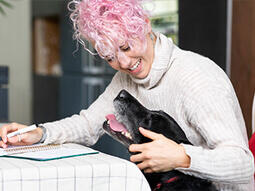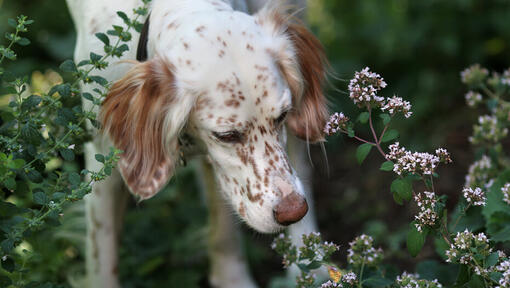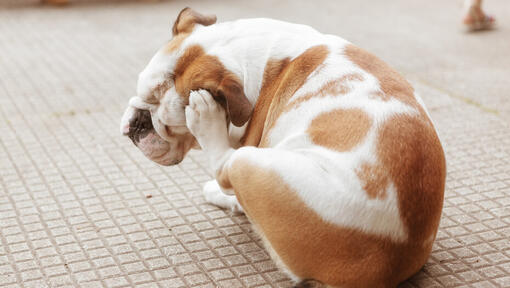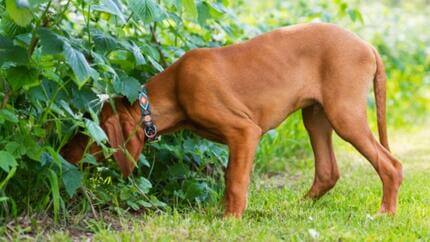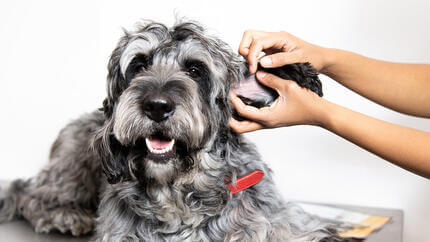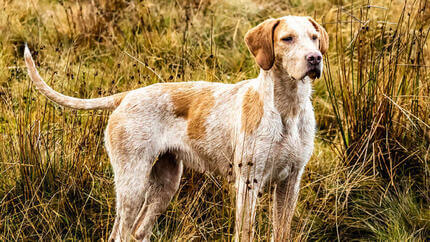
Bees and wasps are among the things that our dogs love to chase most. During the warmer months, we often find them in hot pursuit of these fuzzy insects, but sometimes if they catch them, they can be met with a nasty sting! Find out what to do if your dog’s been stung by a wasp or a bee with our guide.
Dogs are fascinated by bees and wasps. Their lazy buzzing is irresistible to dogs who enjoy chasing games. However, these little insects pack a surprisingly powerful sting when caught.
In most cases if a dog is stung by a bee or wasp, they will experience mild local irritation which should subside within a few hours. However, it can be more serious if dogs receive multiple stings, or if they occur inside the mouth, nose or other sensitive tissues. At Purina, we’ve put together this useful guide to tell you what to do if your dog’s stung by a wasp or bee, the possible symptoms and when to seek help from your vet.
What’s the difference between bee and wasp stings?
If your dog’s been stung by a bee or wasp, it’s important to understand the difference between the two. Bee stings are barbed and lodge in the skin when stinging, detaching from the bee’s body as it pulls away.
This means a bee can only sting once, but the sting may be harder to remove. A wasp or hornet sting, while not barbed, can sting multiple times and can be much more painful and potentially dangerous.
Where are dogs most likely to be stung?
Dogs are often stung on the feet as they inadvertently step on the insect. Other common places for a dog to be stung by a wasp or bee is the nose or mouth. Stings generally cause irritation and swelling which is usually mild and rarely a problem if it occurs on the skin surface. However, if your dog swallows or inhales a bee and is stung at the back of their throat the resultant swelling could potentially block their airway. Monitor your dog to make sure they don’t have an allergic reaction.
Dog stung by wasp or bee symptoms
If your dog’s been stung by a wasp or bee, there are certain symptoms they’ll likely demonstrate, including:
- Whining and restlessness
- Biting or scratching the site of the sting
- Drooling
- Pawing at their face or mouth
- Swelling, heat and redness of the area
- Hives
- Holding up their paw/lameness
If your dog’s experiencing an allergic reaction to the bee or wasp sting, they may display these symptoms:
- Difficulty breathing
- Collapse
- Weakness
- Swelling around the mouth, throat, neck or head
If you notice any of the above symptoms, be sure to contact your vet immediately.
What to do if your dog’s been stung by a bee or wasp
If you’re concerned your dog is having a severe allergic reaction, contact your vet immediately. However, single stings should be mild and self-limiting and often do not require treatment. There are certain things you can do to ease any discomfort.
- Stay calm
- If it is safe to do so, check the area to see if the sting is embedded and needs removing.
- Scrape a sting off using a rigid flat surface, such as a credit card. Pinching the sting out can cause further release of venom.
- Bathe the area in cool water and / or apply ice
- For wasp stings (which are alkaline) you can apply a little vinegar
- For bee stings (which are acidic) you can apply a little bicarbonate of soda.
If the irritation or swelling continues, contact your vet.
Can I give my dog antihistamines for bee or wasp stings?
Some people will suggest giving dogs antihistamines intended for human use if a dog’s been stung by a wasp or a bee.
However, where some are safe for dogs, other types can make them seriously ill so extreme caution needs to be taken. Never give your dog antihistamines without contacting your vet first, they’ll be able to tell you which types are safe and how much is the correct dosage for your pet.
What treatment can my vet give for a bee or wasp sting?
Your vet may give fast-acting injections of antihistamines or steroids to quickly reduce swelling, pain and irritation. This is especially important if your dog is having difficulty breathing due to swelling in the throat. In this instance, your vet may also give your dog oxygen, cool your dog if it is hot and stressed, and can be on hand if emergency airway support is needed. Your vet can also give painkillers.
In very rare cases of life-threatening allergic reaction (anaphylaxis) your vet may give adrenaline, fluid therapy and other supportive treatment.
Can I stop my dog from getting stung?
You would think that once a dog is stung, they would be twice shy! However, for some dogs our buzzing bees and wasps are irresistible and some dogs will never learn. The only way to prevent it is to distract them if they’re actively chasing, or keep them inside during the heat of the day when bees and wasps are most active.
If your dog’s been stung by a bee or wasp, make sure you keep a close eye on the afterwards to make sure no allergic reaction occurs. If the swelling from the sting doesn’t seem to be going away, contact your vet straight away.
That’s our guide on what to do if your dog’s been stung by a wasp or bee! Want to find out more about dog illness symptoms you should look out for? Read our guide on how to remove a tick from your dog.
